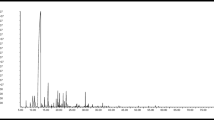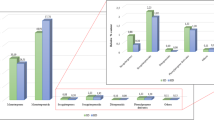Abstract
Effects of microwave assisted hydrodistillation (MAHD) and conventional hydrodistillation (HD) methods on yield, composition, specific gravity, refractive index, and antioxidant and antimicrobial activities of essential oil of Rosmarinus officinalis L were studied. The main aroma compounds of rosemary essential oil were found as 1,8-cineole and camphor. Trolox equivalent antioxidant capacity (TEAC) values for essential oils extracted by MAHD and HD were 1.52 mM/ml oil and 1.95 mM/ml oil, respectively. DPPH radical scavenging activity of the oils obtained by MAHD and HD were found as 60.55% and 51.04% respectively. Inhibitory effects of essential oils obtained by two methods on linoleic acid peroxidation were almost the same. Essential oils obtained by two methods inhibited growth of Esherichia coli O157:H7, Salmonella typhimurium NRRLE 4463 and Listeria monocytogenes Scott A with the same degree. However, inhibitory activity of essential oil obtained by MAHD on Staphylococcus aureus 6538P was stronger than that of obtained by HD (p < 0.05).


Similar content being viewed by others
References
Angioni A, Barra A, Cereti E, Barile D, Coisson JD, Arlorio M, Dessi S, Coroneo V, Cabras P (2004) Chemical composition, plant genetic differences, antimicrobial and antifungal activity investigation of the essential oil of Rosmarinus officinalis L. J Agric Food Chem 52:3530–3535
Atti-Santos AC, Rossato M, Pauletti GF, Rota LD, Rech JC, Pansera MR, Agostini F, Serafini LA, Moyne P (2005) Physico chemical evaluation of Rosmarinus officinalis L. essential oils. Braz Arc Biol Techn 48:1035–1039
Balentine CW, Crandall PG, O’Bryan CA, Duong DQ, Pohlman FW (2006) The pre- and post-grinding application of rosemary and its effects on lipid oxidation and color during storage of ground beef. Meat Sci 73:413–421
Baratta MT, Dorman HJD, Deans SG, Figueiredo AC, Barroso JG, Ruberto G (1998) Antimicrobial and antioxidant properties of some commercial essential oils. Flavour Frag J 13:235–244
Bayramoglu B, Sahin S, Sumnu G (2008) Solvent-free microwave extraction of essential oil from oregano. J Food Eng 88:535–540
Bayramoglu B, Sahin S, Sumnu G (2009) Extraction of essential oil from laurel leaves by using microwaves. Sep Sci Technol 44:722–733
Bousbia N, Vian MA, Ferhat MA, Petitcolas E, Meklati BY, Chemat F (2009) Comparison of two isolation methods for essential oil from rosemary leaves: hydrodistillation and microwave hydrodiffusion and gravity. Food Chem 114:355–362
Braca A, Tommasi ND, Bari LD, Pizza C, Politi M, Morelli I (2001) Antioxidant principles from Bauhinia terapotensis. J Nat Prod 64:892–895
Buffler C (1993) Microwave cooking and processing: engineering fundamentals for the food scientist. Avi Book, New York
Dorman HJD, Peltoketo A, Hiltunen R, Tikkanen MJ (2003) Characterisation of the antioxidant properties of de-odourised aqueous extracts from selected Lamiaceae herbs. Food Chem 83:255–262
Erkan N, Ayrancı G, Ayrancı E (2008) Antioxidant activities of rosemary (Rosmarinus officinalis L.) extract, blackseed (Nigella sativa L.) essential oil carnosic acid rosmarinic acid and sesamol. Food Chem 110:76–82
Estévez M, Cava R (2006) Effectiveness of rosemary essential oil as an inhibitor of lipid and protein oxidation: contradictory effects in different types of frankfurters. Meat Sci 72:348–355
Ferhat MA, Meklati BY, Visinoni F, Vian MA, Chemat F (2008) Solvent free microwave extraction of essential oils – Green chemistry in the teaching laboratory. Chim Oggi 26:48–50
Flamini G, Cioni PL, Morelli I, Macchia M, Ceccarini L (2002) Main agronomic-productive characteristics of two ecotypes of Rosmarinus officinalis L. and chemical composition of their essential oils. J Agric Food Chem 50:3512–3517
Frutos MJ, Hernández-Herrero JA (2005) Effects of rosemary extract (Rosmarinus officinalis) on the stability of bread with an oil garlic and parsley dressing. LWT-Food Sci Technol 38:651–655
Golmakani MT, Rezaei K (2008) Comparison of microwave-assisted hydro distillation with the traditional hydrodistillation method in the extraction of essential oils from Thymus vulgaris L. Food Chem 109:925–930
Güllüce M, Şahin F, Sökmen M, Özer H, Daferera D, Sökmen A, Poissiou M, Adıgüzel A, Özkan H (2007) Antimicrobial and antioxidant properties of the essential oils and methanol extract from Mentha longifolia L.ssp longifolia. Food Chem 103:1449–1456
Hernández-Hernández E, Ponce-Alquicira E, Jaramillo-Flores ME, Legarreta IG (2009) Antioxidant effect of rosemary (Rosmarinus officinalis L.) and oregano (Origanum vulgare L.) extracts on TBARS and color of model raw pork batters. Meat Sci 81:410–417
Karpiǹska-Tymoszezyk M (2011) The effects of oil soluble rosemary extract, sodium erythorbate and a mixture of oil-soluble rosemary extract and sodium erythorbate on the quality of cooked meatballs. J Food Sci Technol. doi:10.1007/s13197-011-0359-3
Kokoska L, Polesny Z, Rada V, Nepovim A, Vanek T (2002) Screening of some Siberian medicinal plants for antimicrobial activity. J Ethnopharmacol 82:51–53
Kosar M, Tunalier Z, Ozek T, Kurkcuoglu M, Baser KHC (2005) A simple method to obtain essential oils from Salvia Triloba L. and Laurus nobilis L. by using microwave-assisted hydrodistillation. Z Naturforsch C 60:501–504
Kuo JM, Yeh DB, Pan BS (1999) Rapid photometric assay evaluating antioxidative activity in edible plant material. J Agric Food Chem 47:3206–3209
Lo Presti M, Ragusa S, Trozzi A, Dugo P, Visinoni F, Fazio A, Dugo G, Mondello L (2005) A comparison between different techniques for the isolation of rosemary essential oil. J Sep Sci 28:273–280
Lucchesi ME, Chemat F, Smadja J (2004a) An original solvent free microwave extraction of essential oils from spices. Flavour Frag J 19:134–138
Lucchesi ME, Chemat F, Smadja J (2004b) Solvent-free microwave extraction of essential oil from aromatic herbs: comparison with conventional hydro-distillation. J Chromatogr A 1043:323–327
Lucchesi M, Smadja J, Bradshaw S (2007) Solvent free microwave extraction of Elletaria cardamomum L.: a multivariate study of a new technique for the extraction of essential oil. J Food Eng 79:1079–1086
Mata AT, Poença C, Ferreira AR, Serralheiro MLM, Nogueira JMF, Araujo MEM (2007) Antioxidant and antiacetylcholinesterase activities of five plants used as Portoguese food spices. Food Chem 103:778–786
Miller NJ, Rice-Evans CA, Davies MJ, Gopinathan V, Milner A (1993) A novel method for measuring antioxidant capacity and its application to monitoring the antioxidant status in premature neonates. Clinical Sci 84:407–412
O’Grady MN, Maher M, Troy DJ, Moloney AP, Kerry JP (2006) An assessment of dietary supplementation with tea catechins and rosemary extract on the quality of fresh beef. Meat Sci 73:132–143
Okoh OO, Sadimenko AP, Afolayan AJ (2010) Comparative evaluation of the antibacterial activities of the essential oils of Rosmarinus officinalis L. obtained by hydrodistillation and solvent free microwave extraction methods. Food Chem 120:308–312
Pintore G, Usai M, Bradesi P, Juliano C, Boatto G, Tomi F, Chessa M, Cerri R, Casanova J (2002) Chemical composition and antimicrobial activity of Rosmarinus officinalis L. oils from Sardinia and Corsica. Flavour Frag J 17:15–19
Ramírez P, Garcia-Risco MR, Santoyo S, Senorans FJ, Ibanez E, Reglero G (2006) Isolation of functional ingredients from rosemary by preparative-supercritical fluid chromatography (Prep-SFC). J Pharmaceut Biomed 41:1606–1613
Re R, Pelegrini N, Proteggente A, Pannala A, Yang M, Rice-Evans C (1999) Antioxidant activity applying an improved ABTS radical cation decolorization assay. Free Rad Biol and Med 26:1231–1237
Pillai P, Ramaswamy K (2011) Effect of naturally occuring antimicrobials and chemical preservatives on the growth of Aspercillus parasiticus. J Food Sci Technol. doi:10.1007/s13197-011-0275-6
Saccheti G, Maietti S, Muzzoli M, Scaglianti M, Manfredini S, Radice M, Bruni R (2005) Comparative evaluation of 11 essential oils of different origin as functional antioxidants, antiradicals and antimicrobials in foods. Food Chem 91:621–632
Santoya S, Cavero S, Jaime L, Ibanez E, Senorans FJ, Reglero G (2005) Chemical composition and antimicrobial activity of Rosmarinus officinalis L. essential oil obtained via supercritical fluid extraction. J Food Protect 68:790–795
Schoenmakers PJ, Oomen JLMM, Blomberg J, Genuit W, Van Velzen G (2000) Comparison of comprehensive two-dimensional gas chromatography and gas chromatography – mass spectrometry for the characterization of complex hydrocarbon mixtures. J Chromatogr A 892:29–46
Stashenko EE, Jaramillo BE, Martinez JR (2004a) Comparison of different extraction methods for the analysis of volatile secondary metabolites of Lippia alba (Mill.) NE brown, grown in Colombia, and evaluation of its in vitro antioxidant activity. J Chromatogr A 1025:93–103
Stashenko EE, Jaramillo BE, Martinez JR (2004b) Analysis of volatile secondary metabolites from Columbian Xylopia aromatica (Lamarck) by different extraction and headspace methods and gas chromatograhpy. J Chromatogr A 1025:105–113
Tigrine-Kordjani N, Chemat F, Meklati BY, Tuduri L, Giraudel JL, Montury M (2007) Relative characterization of rosemary samples according to their geographical origins using microwave-accelerated distillation, solid-phase microextraction and Kohonen self-organizing maps. Anal Bioanal Chem 389:631–641
Uysal B, Sozmen F, Buyuktas BS (2010) Solvent-free microwave extraction of essential oils from Laurus nobilis and Melissa officinalis: comparison with conventional hydrodistillation and ultrasound extraction. Nat Prod Commun 5:111–114
Zhu SK, Lu X, Dong L, Xing J, Su XL, Kong HW, Xu GW, Wu CY (2005) Quantitative determination of compounds in tobacco essential oils by comprehensive two-dimensional gas chromatography coupled to time-of-flight mass spectrometry. J Chromatogr A 1086:107–114
Author information
Authors and Affiliations
Corresponding author
Rights and permissions
About this article
Cite this article
Karakaya, S., El, S.N., Karagozlu, N. et al. Microwave-assisted hydrodistillation of essential oil from rosemary. J Food Sci Technol 51, 1056–1065 (2014). https://doi.org/10.1007/s13197-011-0610-y
Revised:
Accepted:
Published:
Issue Date:
DOI: https://doi.org/10.1007/s13197-011-0610-y




